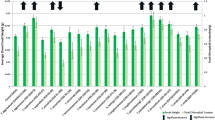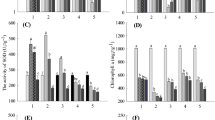Abstract
Geosmin and C-8 hydrocarbons are among the major volatile organic compounds (VOC) responsible for the distinctive, musty odor of filamentous fungi. In this study, we developed a plant bioassay for testing the possible toxicity of these compounds, as well as four air freshener products sometimes used to mask their odor. Seeds and vegetative plants of Arabidopsis thaliana were exposed to 1 ppm of 14 different volatile treatments (both single compounds and mixtures) for 72 h and monitored for germination rate, seedling formation, vegetative plant vigor and chlorophyll concentration. All VOCs tested had some inhibitory effect on seed germination or seedling formation; 1-octen-3-one was the most active, giving almost complete inhibition of germination. Geosmin did not prevent germination (radicle protrusion) but seedling formation was arrested 90 %. Of solvents and fragrance products tested, only the scented oil product was as active as the C-8 biogenic compounds in inhibiting seed germination and seedling formation. Two-week-old plants exposed to 1 ppm of individual fungal VOCs for 72 h all exhibited some degree of stress symptoms including smaller leaf size and weight, discoloration, leaf curling, small necrotic lesions, and reduced chlorophyll concentration. Two-week-old vegetative plants exposed to solvents and air freshener products were generally smaller in size. The single most phytotoxic compound tested was 1-octen-3-one which almost completely inhibited seed germination and was lethal to vegetative phase plants. Formaldehyde at 1 ppm killed 2-week-old seedlings but had little effect on seed germination. In conclusion, the A. thaliana bioassay provides an inexpensive approach for testing the toxicity of gas phase molecules.





Similar content being viewed by others
References
Almeras E, Stolz S, Vollenweider S, Reymond P, Mene-Saffrane L, Farmer EE (2003) Reactive electrophile species activate defense gene expression in Arabidopsis. Plant J 34:202–216
Anjum SA, Xie X, Wang L, Salee MF, Man C, Lei W (2011) Morphological, physiological and biochemical responses of plants to drought stress. Afr J Agric Res 6:2026–2032
Araujo ASF, Monteiro RTR (2005) Plant bioassays to assess toxicity of textile sludge compost. Sci Agricola 62:286–290
Baechler MD, Hadley DL, Marseille TJ, Berry MA (1991) Sick building syndrome. Sources, health effects mitigation. Noyes Data Corporation, Park Ridge
Banks MK, Schultz KE (2005) Comparison of plants for germination toxicity tests in petroleum-contaminated soils. Water Air Soil Pollut 167:211–219
Bartels D, Sunkar R (2005) Drought and salt tolerance in plants. Crit Rev Plant Sci 24:23–58
Berger RG (2007) Flavours and fragrances—chemistry. Bioprocess Sustainability 379
Bhattacharjee S (2012) The language of reactive oxygen species signaling in plants. J Bot. doi:10.1155/2012/985298
Blom D, Fabbri C, Eberl L, Weisskopf L (2011) Volatile-mediated killing of Arabidopsis thaliana by bacteria is mainly due to hydrogen cyanide. Appl Environ Microbiol 77:1000–1008
Bradow JM (1991) Relationships between chemical structure and inhibitory activity of C6 through C9 volatiles emitted by plant residues. J Chem Ecol 17:2193–2198
Cape JN (2003) Effects of airborne volatile organic compounds on plants. Environ Pollut 122:145–157
Ebi KL, McGregor G (2008) Climate change, tropospheric ozone and particulate matter, and health impacts. Environ Health Perspect 116:1449–1455
EPA (1994) US Environmental Protection Agency catalogue of standard toxicity tests for ecological risk assessment publication 9345.0-05I. Intermittent Bull 2:3–4
Gutiérrez-Luna FM, López-Bucio J, Altamirano-Hernández J, Valencia-Cantero E, de la Cruz HR, Macías-Rodríguez L (2010) Plant growth-promoting rhizobacteria modulate root-system architecture in Arabidopsis thaliana through volatile organic compound emission. Symbiosis 51:75–83
Heller J, Tudzynski P (2011) Reactive oxygen species in phytopathogenic fungi: signaling, development, and disease. Annu Rev Phytopathol 49:369–390
Herrmann A (2010) The chemistry and biology of volatiles. Hoboken, Wiley
Hung R, Lee S, Bennett JW (2013) Arabidopsis thaliana as a model system for testing the effect of Trichoderma volatile organic compounds. Fungal Ecol 6:19–26
Inamdar AA, Moore JC, Cohen RI, Bennett JW (2011) A model to evaluate 424 the cytotoxicity of the fungal volatile organic compound 1-octen-3-ol in human embryonic stem cells. Mycopathologia 173:13–20
Jaleel CA, Sankar B, Sridharan R, Panneerselvam R (2007) Soil salinity alters growth, chlorophyll content, and secondary metabolite accumulation in Catharanthus roseus. Turk J Biol 32:79–83
Jiang J, He X, Cane D (2007) Biosynthesis of the earthy oderant geosmin by a bifunctional streptomyces coelicolor enzyme. Nat Chem Bio 3:711–715
Juang DF, Lee CH, Chen WC, Yuan CS (2010) Do the VOCs that evaporate from a heavily polluted river threaten the health of riparian residents? Sci Total Environ 408:4524–4531
Kishimoto K, Matsui K, Ozawa R, Takabayashi J (2007) Volatile 1-octen-3-ol induces a defensive response in Arabidopsis thaliana. J Gen Plant Pathol 73:35–37
Korpi A, Jarnberg J, Pasanen AL (2009) Microbial volatile organic compounds. Crit Rev Toxicol 29:139–193
Kreja L, Seidel HJ (2002) On the cytotoxicity of some microbial volatile organic compounds as studied in the human lung cell line A549. Chemosphere 49:105–110
Li DW, Yang CS (2004) Fungal contamination as a major contributor to sick building syndrome. Adv Appl Microbiol 55:31–112
Mafakheri A, Siosemardeh A, Bahramnejad B, Struik PC, Sohrabi E (2010) Effect of drought stress on yield, proline and chlorophyll contents in three chickpea cultivars. Aust J Crop Sci 4:580–585
Mølhave L (2009) Volatile organic compounds and the sick building syndrome. In: Lippmann M (ed) Environmental toxicants: human exposures and their health effects. Wiley-Interscience, New York, pp 241–256
Mutters RG, Madore M, Bytnerowicz A (1993) Formaldehyde exposure affects growth and metabolism of common bean. J Air Waste Manag Assoc 43:113–116
Nikolaou AD, Golfinopoulos SK, Kostopoulou MN, Kolokythas GA, Lekkas TD (2002) Determination of volatile organic compounds in surface waters and treated wastewater in Greece. Water Res 36:2883–2890
Ogura T, Sunairi M, Nakajima M (2000) 2-Methylisoborneol and geosmin, the main sources of soil odor, inhibit the germination of Brassicaceae seeds. Soil Sci 46:217–227
Ommen OE, Donnelly A, Vanhoutvin S, van Oijen M, Manderscheid R (1999) Chlorophyll content of spring wheat flag leaves grown under elevated CO2 concentrations and other environmental stresses within the ESPACE-wheat project. Eur J Agron 10:197–203
Ortiz-Castro R, Contreras-Cornejo H, Macias-Rodriguez L, Lopez-Bucio J (2009) The role of microbial signals in plant growth and development. Plant Signal Behav 4:701–712
Palta JP (1990) Leaf chlorophyll content. Remote Sens Rev 5:207–213
Potera C (2011) Indoor air quality: scented products emit a bouquet of VOCs. Environ Health Perspect 119:A16
Rajjou L, Duval M, Gallardo K, Catusse J, Bally J, Job C, Job D (2012) Seed germination and vigor. Annu Rev Plant Biol 63:507–533
Splivallo R, Novero M, Bertea MC, Bossi S, Bonfante P (2007) Truffle volatiles inhibit and induce an oxidative burst in Arabidopsis thaliana. New Phytol 175:417–424
Splivallo R, Fischer U, Göbel C, Feussner I, Karlovsky P (2009) Truffles regulate plant root morphogenesis via the production of auxin and ethylene. Plant Physiol 150:2018–2029
Steinemann AC, MacGregor IC, Gordon SM, Gallagher LG, Davis AL, Ribeiro DS, Wallace LA (2010) Fragranced consumer products: chemicals emitted, ingredients unlisted. Environ Impact Assess Rev. doi:10.1016/j.eiar.2010.08.002
Steiner AL, Tonse S, Cohen RC, Goldstein AH, Harley RA (2006) Influence of future climate and emissions on regional air quality in California. J Geophysical Res 111:D18303. doi:10.1029/2005JD006935
Stensmyr MC, Dweck HKM, Farhan A, Ibba I, Strutz A, Mukunda L, Linz J, Grabe V, Steck K, Lavista-Llanos S, Wicher D, Sachse S, Knaden M, Becher PG, Seki Y, Hansson BS (2012) A conserved dedicated olfactory circuit for detecting harmful microbes in Drosophila. Cell 151:1345–1357
Straus DC (2004) Sick building syndrome. In: Advances in applied microbiology, vol 55. Elsevier, Amsterdam
Takigawa T, Wang BL, Saijo Y, Morimoto K, Nakayama K, Tanaka M, Shibata E, Yoshimura T, Chikara H, Ogino K (2009) Relationship between indoor chemical concentrations and subjective symptoms associated with sick building syndrome in newly built 516 houses in Japan. Int Arch Occup Environ Health 83:225–235
Thordal-Christensen H, Zhang Z, Wei Y, Collinge DB (1997) Subcellular localizastion of H2O2 in plants. H2O2 accumulation in papillae and hypersensitive response during the barley–mildew interaction. Plant J 11:1187–1194
Vokou D, Douvli P, Blionis GJ, Halley JM (2003) Effects of monoterpenoids, acting alone or in pairs, on seed germination and subsequent seedling growth. J Chem Ecol 29:2281–2301
Walinder R, Ernstgard L, Johanson G, Norback D, Venge P, Wieslander G (2005) Acute effects of a fungal volatile compound. Environ Health Perspect 113:1775–1778
Wang X, Sun C, Gao S, Wang L, Shuokui H (2001) Validation of germination rate and root elongation as indicator to assess phytotoxicity with Cucumis sativus. Chemosphere 44:1711–1721
Watson S (2003) Cyanobacterial and eukaryotic algal odour compounds: signals or by-products? A review of their biological activity. Phycologia 42:332–350
WHO (2009) Guidelines for indoor air quality: dampness and mold. Druckpartner Moser, Germany
Wilkins K, Larsen K, Simkus M (2000) Volatile metabolites from mold growth on building materials and synthetic media. Chemosphere 41:437–446
Zogorski JS, Carter JM, Ivahnenko T, Lapham WW, Moran MJ, Rowe BL, Squillace PJ, Toccalino PL (2006) The quality of our nation’s waters—volatile organic compounds in the nation’s ground water and drinking-water supply wells. US Geological Surv Circular 1292:101
Acknowledgments
We are grateful to Barbara Zilinskas, Prakash Masurekar, Arati Inamdar, and Sally Padhi for their intellectual input. This research was supported by funds from Rutgers, The State University of New Jersey and National Science Foundation Graduate Research Fellowship under Grant No. 0937373 to S.L.
Author information
Authors and Affiliations
Corresponding author
Rights and permissions
About this article
Cite this article
Lee, S., Hung, R., Schink, A. et al. Arabidopsis thaliana for testing the phytotoxicity of volatile organic compounds. Plant Growth Regul 74, 177–186 (2014). https://doi.org/10.1007/s10725-014-9909-9
Received:
Accepted:
Published:
Issue Date:
DOI: https://doi.org/10.1007/s10725-014-9909-9




